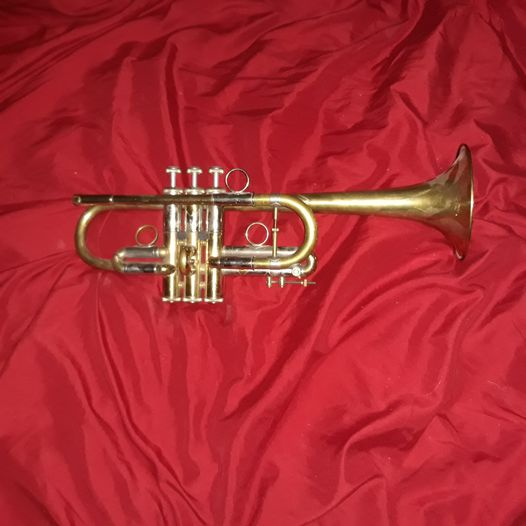My bad D
-

My D trumpet. Elkhart Bach, 236 bell. Tuning slide by Matthias Beck. over-under first valve slide with ring., shortened third slide, and brace removal by Norbert Böpple, and a couple of gadgets from Ivan Hunter--his adjustable tuning slide brace lets me switch from brighter to darker, and he's got some sort of dampeners for between the valves that seems to improve slotting.
It has a glorious sound and a fine blow, but the G in the staff is so flat that it has to be played 1-3. I don't like that. I have an old Monette leadpipe that I haven't soldered on yet, and the G is still flat. No matter the mouthpiece, the G is flat.
Anyone else have this problem with their D180?
Anyone know how to fix it? -
@vulgano-brother Intonation issues can have hundreds of reasons (like the parts simply not working together). In the modification of my Bach 229 CL, I found a lot of things.
- the position of the bell braces "lock" the various slots in, The G and C in the staff seem to be most affected by the bell brace closest to the mouthpiece. Strong slots will make the instrument harder to play. I suggest trying to move that brace closer to the valve block (or just removing it for testing).
- I use a heavier bottom valve cap on valve 3. That stabilized a lot of things
- the receiver/mouthpiece gap did not change the intonation, but it did improve my feeling of being connected to the horn. My artisan had a mouthpiece shank shaped tool and he inserted and tapped with a hammer. I suspect that this compressed the brass slightly and let the mouthpiece be inserted more deeply and firmly.
- Round tuning slides never worked for me. I tried ovate, D shapes and round ones with the D shape having the most "core", the "ovate" having the most colors, and round neither.
- I also discovered that at least with the Bach, it was beneficial for intonation to have a slightly smaller bore where the bell meets the valve block. I accomplished this by making a tuning bell. The braces are permanently attached to the bell, and use adjustable slides on the leadpipe (like with adjustable 3rd slide finger rings)
Looking at your horn, I get the impression that the round tuning slide is cylindrical. That makes the leadpipe VERY short. On the short horns, I think that a tapered tuning slide could be beneficial. Even better would probably be to use a cornet as the base for a D trumpet. The Eb cornets that I have played generally have better intonation than the Eb trumpets.
I suspect that although the instrument is well put together, the R&D to balance everything out is missing. My Selmer Radial2° D/Eb only has the 4th space E and Eb way too low. I have had the horn since 1975 and just have never gotten around to doing anything with it. I will one day.
-
I tried the Monette leadpipe again. It is about one receiver longer than the Bach, and it fixes the g nicely. Time to cultivate a local American tech to put it on. It will change brace placement for sure. (I had the braces removed Spada does [without the fine tuning] previously.)
As for slide shape, I don't like the edge that comes with the Bach D core. It just sits there and buzzes and there isn't too much ability to color it. Haven't experienced ovate slides on my D yet, but I find my round one gives me a warm, highly compact C sound that I like, kind of like a mythical Gil Johnson D sound. Thinking of moving the bell brace up a bit for more feedback.
Isn't playing with horns fun?
(That's another way of saying "Why didn't it work right out of the factory?")
Playing horns is even more fun, so please excuse me while I practice.